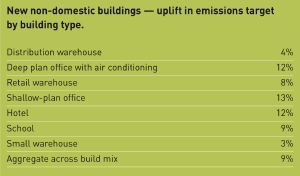So what has changed in Part L 2013?

Now that the complete Part L 2013 has been published, what do the changes mean for the building services sector? Hywel Davies of CIBSE considers the 2013 updates.
In August 2013 we had the revised Building Regulations, and in the autumn new Part L Approved Documents for new buildings (ADL1A and 2A) and updated Compliance Guides were issued. Now, with the amendments to the Part L Approved Documents for works to existing buildings (ADL1B and 2B) and release of the 2013 versions of SAP and SBEM, the Part L 2013 picture is pretty much complete.
We now know the major changes for 2013. Homes will require a calculation of the fabric energy efficiency, both at the design stage and on completion. This should be provided to the building-control officer, in the same way as airtightness test results should be submitted. Overall, new homes built to the 2013 regulations must achieve a 6% improvement in carbon emissions relative to 2010.
New non-domestic buildings will, on aggregate, need to achieve a 9% improvement. ‘On aggregate’ means that the exact figure varies from one building type to another. This concept recognises that it is easier to make further reductions in hotels and deep-plan air-conditioned buildings than in distribution warehouses, for example, where further increases in insulation are likely to reduce heating-related emissions, but are now likely to trigger greater demand for cooling in the summer. The targets by type have now been included in Table 5 of Approved Document L2A, rather than being hidden away in the National Calculation Methodology Modelling Guide, although there is further detail there if required.
To support these changes there is a wider range of notional non-domestic buildings for use when calculating compliance. This includes smaller warehouses and top-lit and side-lit buildings.
The Department of Communities & Local Government anticipates that these requirements are achievable through good building fabric and building-services design, construction and installation in most building types.
There are changes to the standards for building services. These include the introduction of the Lighting Energy Numerical Indicator (LENI) as an alternative compliance option for lighting for those who do not wish to use the existing approach. This option is something which lighting professionals, led by the Society of Light & Lighting, have been seeking for some time and helps to align lighting design practice with other aspects of European Standards for lighting design.
Competent lighting designers now have the option of using the additional flexibility and design freedom which the LENI approach offers, whilst leaving the previous, rather more prescribed, approach in place, with an increase in initial luminaire efficacy to 60 lamp lumens per circuit watt.

There has also been some alteration or ‘strengthening’ of the standards for chillers and fan-coil units. The minimum cooling efficiency of chillers is increased from 2.5 to 2.7, and the specific fan power of fan coil units is reduced from 0.6 to 0.5 W/l/s. It is also worth noting that in calculating the costs of these changes, a service life of 15 years is assumed for the fan coils and chillers, and 20 years for lighting. Other aspects of the building are assumed to have a service life of 60 years, for the purposes of calculating costs for the impact assessment.
The 2013 edition of the regulations also includes consolidated requirements introduced in 2012 to implement some aspects of the Energy Performance of Buildings Directive (EPBD), which requires ‘the feasibility of high-efficiency alternative systems to be taken into account before construction commences’.
A further welcome change is to the layout of the Approved Documents, which are now in a single-column format and so far easier to read on screen on a desktop, laptop or even a tablet, and is quite a familiar print format, too.
Finally, Part L only applies to England, and not to Wales, which is producing its own regulations and guidance for the first time since Building Regulations were devolved to the Welsh Assembly.
The new guidance comes into effect on 6 April 2014. Any work started before then is covered by the 2010 edition of the guidance. Any work which is subject to a building notice, full plans application or an initial notice submitted before 6 April 2014 will also be covered by the 2010 guidance, provided it is started before 6 April 2015.
Hywel Davies is technical director of CIBSE.







